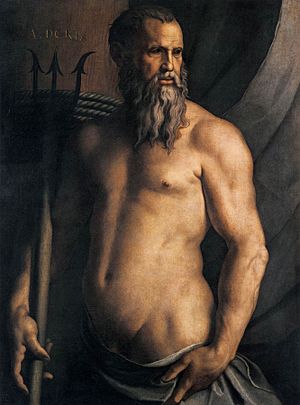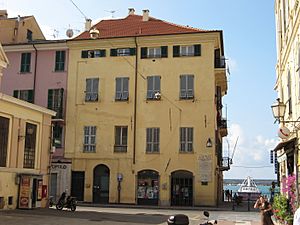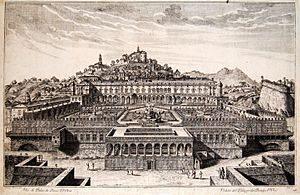Andrea Doria facts for kids
Quick facts for kids
Andrea Doria
|
|
|---|---|

|
|
| Born | 30 November 1466 Oneglia, Republic of Genoa |
| Died | 25 November 1560 (aged 93) Genoa, Republic of Genoa |
| Allegiance | |
| Battles/wars |
|
| Signature | |
Andrea Doria (born November 30, 1466 – died November 25, 1560) was a very important Italian leader. He was a skilled admiral and a statesman from Genoa, a powerful city-state in Italy. He was also known as the Prince of Melfi.
Andrea Doria played a key role in the Republic of Genoa during his long life. He helped change how Genoa was governed, making sure it stayed a strong republic. He is also considered one of the best naval leaders of his time. Many ships have been named after him, including the famous Italian passenger ship SS Andrea Doria, which sank in 1956.
Contents
Early Life of Andrea Doria
Andrea Doria was born in Oneglia, a town that was part of the Republic of Genoa. He came from the Doria family, an old and important family in Genoa. This family had been very influential in the Republic since the 1100s.
Andrea Doria became an orphan when he was young. He decided to become a soldier, fighting for different Italian princes. He first served in the Pope's guard.
In 1503, Andrea Doria started fighting in Corsica for the Genoese Navy. At that time, Genoa was under French control. He helped lead Genoa's fight against the French, forcing them to leave the city. From then on, he became famous as a naval commander.
For many years, he sailed the Mediterranean Sea with the Genoese fleet. He fought against the Ottoman Turks and Barbary pirates. He even defeated them in a battle near Pianosa.
Genoa was later taken over by the French again, and then by the Spanish in 1522. But Doria joined forces with the French King Francis I of France. The king made him a captain-general. In 1524, Doria helped protect Marseille from attackers. He also helped Genoa become French again. His nephew, Filippino Doria, led Doria's ships to a big victory over a Spanish fleet in 1528.
However, Andrea Doria was not happy with King Francis. The king was slow to pay him and did not keep his promise to return the city of Savona to Genoa. So, in June 1528, Doria decided to work for Emperor Charles V of Spain.
As an admiral for the Emperor, Doria led several missions against the Ottoman Empire. He captured cities like Koroni and Patras. He also helped Emperor Charles V capture Tunis in 1535. Charles V found Doria to be a very valuable ally in his wars. With Doria's help, Spain gained more control over Italy.
In 1538, a group of European powers, including Spain and the Pope, formed a "Holy League" against the Ottomans. But the Ottoman fleet, led by Hayreddin Barbarossa, defeated Doria's combined fleet at the Battle of Preveza. This victory gave the Ottomans control of the eastern Mediterranean Sea for many years.
Doria also joined Emperor Charles V on a difficult mission to Algiers in 1541. Doria did not think it was a good idea, and the mission ended badly. For the next five years, Doria continued to serve the Emperor. Even though he was over 70 years old, he was still very active and usually successful.
Leading the Genoese Republic

In September 1528, Andrea Doria and his forces drove the French out of Genoa. The city welcomed him as a hero.
Doria then changed Genoa's government to be more stable. He created a new system led by the city's main noble families. He refused to become the ruler of Genoa or even the Doge (the chief magistrate). Instead, he accepted the title of "perpetual censor." This title meant he was a highly respected senior public official, similar to ancient Roman censors. He had a lot of influence in Genoa's government until he died. He was given two palaces and many special rights. He was also called "Liberator and Father of His Country."
To protect Genoa from future attacks, Andrea Doria supported building a new city wall. This wall was designed by Giovanni Maria Olgiati and followed the path of older walls. But it used new, stronger designs with triangular bastions.
Later Years and Legacy
After a peace treaty in 1544, Doria hoped to live out his final years quietly. However, his great wealth and power, along with the proud behavior of his nephew Giannettino Doria, created many enemies. In 1547, a plot known as the Fieschi conspiracy tried to remove his family from power. Giannettino was killed, but the plot failed. Doria punished the conspirators severely.
Other plots followed, but they all failed. Even though Doria could be harsh, he was a true patriot. He successfully stopped Emperor Charles V from building a Spanish fort in Genoa. Neither promises nor threats could make him agree to it.
Age did not slow him down much. In 1550, at 84 years old, he sailed again to fight the Barbary pirates, but without much success. In 1552, the Ottoman fleet defeated Doria's Spanish-Italian fleet in the Battle of Ponza (1552). When war broke out between France and the Empire again, the French took Corsica in 1553. Corsica was then controlled by Genoa. Doria was called back to fight. He spent two years (1553–1555) on the island, fighting the French with mixed results.
He returned to Genoa for good in 1555. Being very old and unwell, he gave command of his ships to his great-nephew, Giovanni Andrea Doria. Giovanni Andrea led a mission against Tripoli, but it was not successful. He barely escaped with his life after losing a battle against the Turkish fleet. Andrea Doria left all his property to Giovanni Andrea. The Doria-Pamphili-Landi family today is descended from Giovanni Andrea Doria.
Ships Named After Andrea Doria
Many ships have been named in honor of Admiral Andrea Doria:
- Two United States Navy ships named USS Andrew Doria (from 1775 and 1908).
- The Italian ironclad Andrea Doria, completed in 1891.
- The Italian battleship Andrea Doria, completed in 1916, which served in both World War I and World War II.
- The Italian passenger liner SS Andrea Doria, launched in 1951, which sank after a collision in 1956.
- The Italian missile cruiser Andrea Doria, built in 1964.
- The Italian destroyer Horizon-class destroyer Andrea Doria, commissioned in 2007.
Paintings and Commemorations
A painted sheepskin honoring "The Magnificent and Excellent Andrea Doria" is displayed at The Breakers in Newport, Rhode Island, USA.
Images for kids
-
Portrait of Andrea Doria, c. 1520, by Sebastiano del Piombo
See also
 In Spanish: Andrea Doria para niños
In Spanish: Andrea Doria para niños







